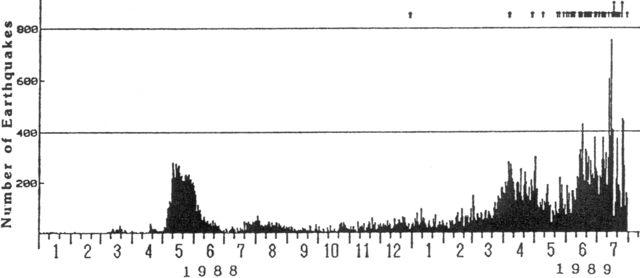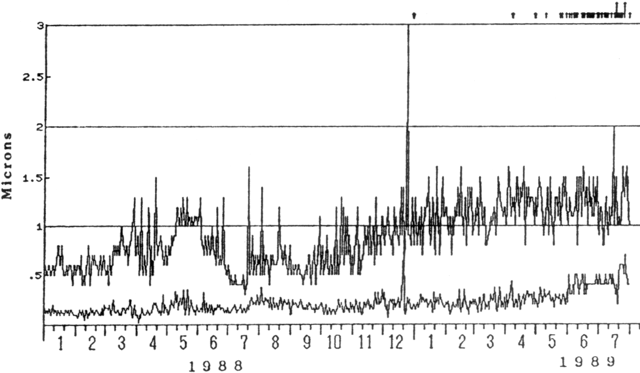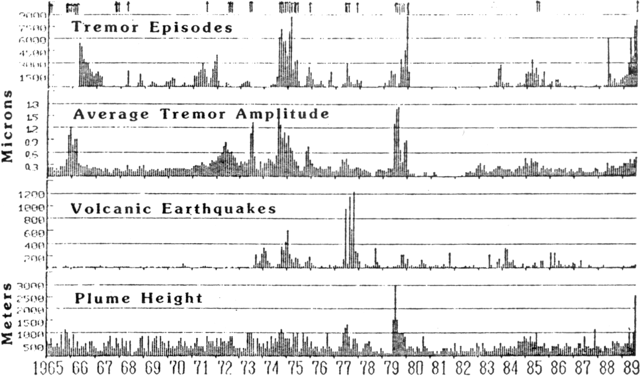Report on Asosan (Japan) — July 1989
Scientific Event Alert Network Bulletin, vol. 14, no. 7 (July 1989)
Managing Editor: Lindsay McClelland.
Asosan (Japan) First strong eruption since 1985 ejects ash to 2,500 m
Please cite this report as:
Global Volcanism Program, 1989. Report on Asosan (Japan) (McClelland, L., ed.). Scientific Event Alert Network Bulletin, 14:7. Smithsonian Institution. https://doi.org/10.5479/si.GVP.SEAN198907-282110
Asosan
Japan
32.8849°N, 131.085°E; summit elev. 1592 m
All times are local (unless otherwise noted)
On 16 July, Aso erupted vigorously for the first time since May-June 1985, with three ash explosions from Crater 1 (at 1354, 1603, and 1625). The eruption resumed on 24 July, ejecting ash to 2,000 m above the crater rim.
Activity at Crater 1 has been gradually increasing since the end of 1988 (figure 12). Visits to the volcano October 1988-5 August 1989 revealed red glow at vents and cracks on the crater floor. After a small ash ejection on 5 April, tephra emission continued at a relatively high rate in May and June. A new vent (891) on the crater floor, first noticed during a field survey 11 June, emitted an ash-laden plume almost every day in July. Ash often fell near the vent, and daily accumulations of 7 g/m2 on 6 July, 11 g/m2 on 7 July, and 6 g/m2 on 8 July were measured at AWS.
On 14 July, the largest daily number of isolated volcanic tremor episodes (744) in 1989 was recorded by a seismometer 0.8 km W of Crater 1 (figure 13). The same day, at 1535, the amplitude of continuous tremor increased (figure 14), and white vapor and ash from Vent 891 was ejected to 1,200 m. A 1-km area around the crater was again closed to tourists by the Aso Disaster Prevention Authority. Two days later, at 1155, tremor amplitude began to increase, decreased sharply at 1303, but increased again at 1344, 10 minutes before the onset of ash emission. Ash reached about 2,500 m height at 1355. After a sharp decrease in tremor amplitude, two ash explosions followed at 1603 and 1625, ejecting a plume to ~1,000 m.
 |
Figure 13. Daily number of isolated tremor episodes at Aso, January 1988-July 1989. Arrows represent eruptions. Courtesy of JMA. Courtesy of JMA. |
 |
Figure 14. Daily maximum tremor amplitude (top) and average amplitude of continuous tremor (bottom) at Aso, January 1988-July 1989. Arrows represent eruptions. Courtesy of JMA. |
On 18-19 July, small amounts of ash were repeatedly ejected from Vent 891 after tremor amplitude sharply decreased. During a field survey at 1920 on 22 July, a maximum brightness temperature of 506°C was measured (by an infrared radiation thermometer) at a vent on the crater floor. The amplitude of continuous tremor began to increase 21 July, and significantly increased on the night of 23 July. Ash emission resumed at 1620 on 24 July and continued for about 1 hour, attaining a maximum height of 2,000 m above the crater rim. A small ash ejection was observed during a field survey on 29 July. Brightness temperatures near the vent on the crater floor were 504°C on the 29th and 498°C on the 30th. The average amplitude of continuous tremor remained high.
Geological Summary. The 24-km-wide Asosan caldera was formed during four major explosive eruptions from 300,000 to 90,000 years ago. These produced voluminous pyroclastic flows that covered much of Kyushu. The last of these, the Aso-4 eruption, produced more than 600 km3 of airfall tephra and pyroclastic-flow deposits. A group of 17 central cones was constructed in the middle of the caldera, one of which, Nakadake, is one of Japan's most active volcanoes. It was the location of Japan's first documented historical eruption in 553 CE. The Nakadake complex has remained active throughout the Holocene. Several other cones have been active during the Holocene, including the Kometsuka scoria cone as recently as about 210 CE. Historical eruptions have largely consisted of basaltic to basaltic-andesite ash emission with periodic strombolian and phreatomagmatic activity. The summit crater of Nakadake is accessible by toll road and cable car, and is one of Kyushu's most popular tourist destinations.
Information Contacts: JMA.


